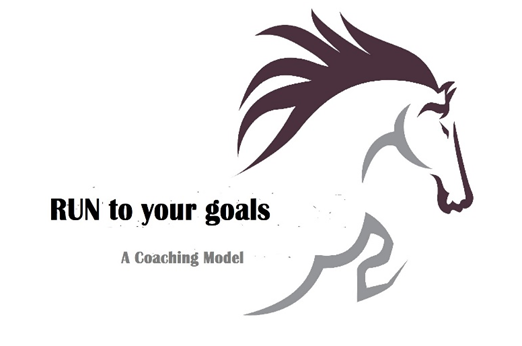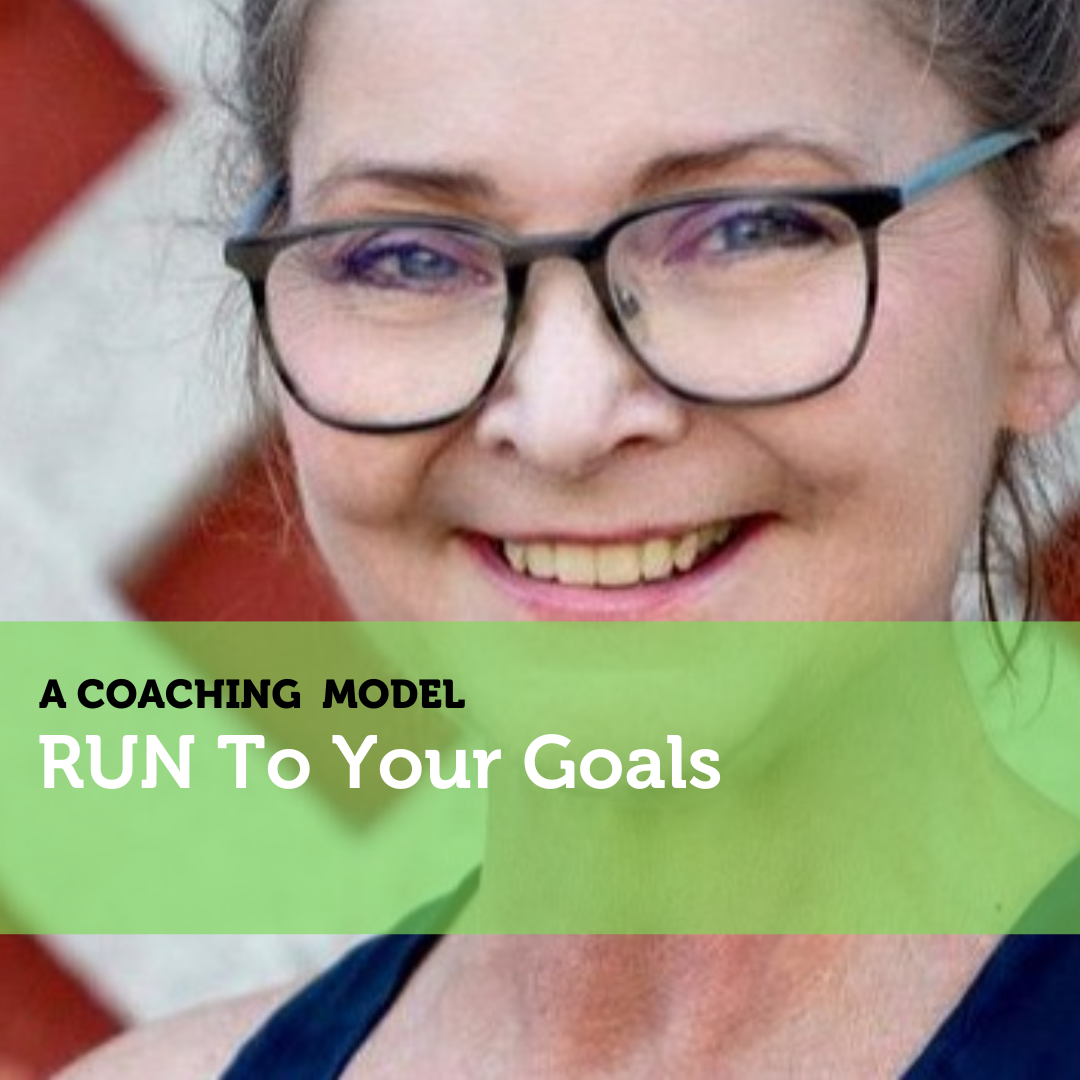A Coaching Model By Sharee S Wells, Career Obstacles Coach, UNITED STATES

Coaching with the RUN Model
A big fan of the GROW model of coaching, for purposes of certification, it is necessary to devise an original. So based on various adaptations of GROW, this is a streamlined model called the RUN model of coaching.
Envision yourself as a beautiful thoroughbred, a racehorse, well-fed, well-groomed, and free to roam the lush green of the paddock. Imagine your favorite activity is a full gallop through the fields, the wind blowing through your flowing mane, your nostrils flared, your breath deep and strong, the scent of the dirt and the grass, your hoofs pounding the course confidently, surely, your elegant tail streaming behind you as you run at full speed to the finish line… See, hear, smell, and feel what it is to really RUN.
When met with problems or risks people often are struck by the instinct known as the “Fight or Flight Response”. A third response sometimes is sometimes developed: Fight, Flight, or Freeze as mentioned in other studies on the topic. To save our children from harm, we are likely to run toward danger to fight it. To save ourselves from being hit by an oncoming car, we are more likely to run away from the danger – to take flight. To save ourselves or our children from a possibly poisonous snake (no matter how much we want to take the flight response), we are taught to freeze so the snake will not sense that we require attacking. The reactions were studied in the 1920s by Professor Walter Cannon, Chair of Physiology at Harvard Medical School. The phrase “Fight or Flight” was popularized in his book, The Wisdom of the Body, published in 1932. Freezing may paralyze us. Fight or flight can save us or damage us but, in either case – whether to or from – our instinct is to run. Thus, the coaching model RUN was born hoping clients will RUN toward their better futures with confidence, power, and grace.
The RUN Model
 RUN stands for:
RUN stands for:
Real-Time
Ulterior Motive
New Growth
Real-Time means looking at what is currently happening in clients’ lives. What is their reality and how are they perceiving that reality? Ulterior Motive goes deeper to examine clients’ underlying beliefs and attitudes that may be hindering or helping forward progress. Then, armed with the awareness of the situation and what clients believe about it, New Growth spurs on the process with visions of success, inquiries into solution options, and what is needed to put chosen options into action. New Growth also looks into client willingness, commitment, and accountability to themselves. Next, look at what each component offers both coaches and clients.
Real-Time
For Coaches: Only when clients understand and articulate their current reality can a coach ask effective questions in all other elements of any coaching model. First then, coaches must look at clients’ perspectives on their current situations. Coaches ask how clients are affected by the current situation physically, mentally, and emotionally. Gathering information on the problem, its duration, and the interest of clients in making a change strengthens the coaching relationship. Also, coaching inquiries about which client values are impacted and any prior experience clients have had with similar situations demonstrate a genuine interest in clients. In short, coaches will focus on who their clients are under their current conditions.
For Clients: The current situation is the place to start with clients too, so they can clarify their position and build on the trusting relationship with their coach. Clients are often overwhelmed by their immediate reactions to a situation (fight, flight, freeze?) Frequently, they haven’t made time to breathe, much less consider what it means to them and if it’s even anything they control. Clarifying the most burdensome aspect within their control, clients can then focus on their values, attitudes, and changes that move them toward their goal
Real-Time Questions
- What are you exploring today?
- What makes that important to you right now?
- What one thing do you want to address in our limited timeframe today?
- How much control do you have over the outcome/Who else is involved/in control?
- How is that situation holding you back?
- How do you know that your perception is accurate?
- When things don’t go well in this situation, how are you affected/How are others involved affected?
- How have you handled that before?
- What have you done to handle this situation so far?
- What have been your results?
- What did you learn about yourself?
- What skills/abilities/resources are you not using for this?
- What have you avoided saying about what’s going on?
Ulterior Motives
For Coaches: Coaches ask about what’s happening in their clients’ lives/emotions/bodies. When coaches’ questions go deeper it brings client consciousness to a level of comprehending not only their situation but also the effect of it on their realities and emotions. Listening actively and compassionately to what’s underneath client reactions, coaches stay focused on the “who” of each client and avoid the trap of getting lost in their stories.
For Clients: While exploring their underlying beliefs, clients develop awareness about themselves, their attitudes, priorities, values, and what it means to be them under these conditions. Clients can then determine their willingness and motivation to change, maintain, or leave their current situations.
Ulterior Motive Questions
- How do you feel about/How are you experiencing TOPIC?
- What is holding you back/preventing you from doing what you want about it?
- What if you change nothing / How is keeping things the same serving you?
- What would you like to be different about this?
- What will your experience be when you change it?
- You said ___________. What does that mean to you?
- I observed ___________. What are you thinking/feeling?
- How does ____________ affect your daily life?
- What is happening now in your mind/body/spirit?
- What do you think/feel about that?
- What must change for that to be better/work out for you?
- What will you think/feel if you make that/those change(s)?
- If awareness occurs: You’ve become aware of ______. How does that shift your outlook?
New Growth
For Coaches: Coaching questions about options and actions help clients address that feeling of needing to “do something” about their current situation. When coaches inquire about client solution options and preferences, they offer a space for creative or imaginative thinking. Coaches use these questions to help clients further refine, clarify, and organize any action they are willing to take to resolve their situations. In addition, exploring the effects of various alternatives keeps coaches genuinely present and concerned for their client’s well-being.
For Clients: Coaching clients often come to sessions wanting a plan of action to manage or dispose of current negative situations. Others come wanting to correct perceived negative behaviors or adopt perceived positive ones. Still, others want a new view or new attitude toward their circumstances. Questions about new ways to grow or new attitudes toward growth help clients develop a clear picture of the necessary steps and resources they can use to achieve their goals. With inquiries focused on wide arrays of options, clients sense their freedom to imagine and create what works for them. Clients gain awareness of their strengths and grow confident in their ability to RUN to the goal, handling current and future situations with calmly considered responses.
New Growth Questions
- What can you do to make the change you want?
- What options are available?
- What option(s) do you choose / How will you make the change?
- Imagine making the change: What does that look like? Sound like? Feel like?
- What is the first step to making that vision happen?
- What is blocking your way?
- If realization dawns ask: How can you clarify that new awareness?
- What resources do you need to complete that first step?
- When will you do the first step?
- Close your eyes. What comes next?
- What could prevent you from taking Step 2?
- What resources do you need to complete the second step?
- When will you start Step 2?
… Repeat through however many steps it takes…
- What else is needed to make this change happen?
- What are the costs involved?
- What resources are still needed?
- Is anything missing?
- You developed a plan! What did you learn/reinforce about yourself in the process?
- How will you hold yourself accountable to your action plan?
- How are you feeling / What do you think about your plan of action?
- When will you begin acting on your plan?
- You’ve done a lot today. How would you like to end the session?
RUN Model’s Benefits for Clients and Coaches
Any coach and client can use the RUN model to develop a relationship built on trust, listening (HEARING), and confidence in one another. Even better, it frees clients to RUN to their goals…
Learn How to Create Your Own Coaching Model
Your Coaching Model reflects your values,
philosophies, and beliefs and must communicate who you will coach
and the problems you will solve. Read more about creating your coaching model
References
Cannon, Walter B. The wisdom of the body. New York: W. W. Norton(1939)
Whitmore, Sir J. Coaching for Performance. London, Brealey(2019)
ICA Coaching Model Coursework (2020-2022)
Free Plagiarism Checker Online for Students – PapersOwl Score: 0% Plagiarized, 100% Unique
